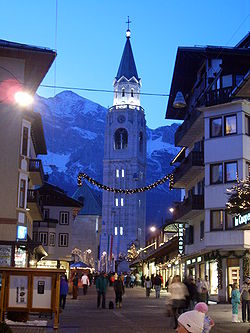Cortina d’Ampezzo
|
Cortina Anpezo (Ampëz) |
||
|---|---|---|
| Comune | ||
| Comune di Cortina d'Ampezzo | ||

The town centre of Cortina d'Ampezzo
|
||
|
||
 The Comune of Cortina d'Ampezzo shaded red in the Province of Belluno |
||
| Location of Cortina in Italy | ||
| Coordinates: 46°32′25″N 12°08′10″E / 46.54028°N 12.13611°ECoordinates: 46°32′25″N 12°08′10″E / 46.54028°N 12.13611°E | ||
| Country | Italy | |
| Region | Veneto | |
| Province / Metropolitan city | Belluno (BL) | |
| Frazioni | see list | |
| Government | ||
| • Mayor | Andrea Franceschi | |
| Area | ||
| • Total | 254.51 km2 (98.27 sq mi) | |
| Elevation | 1,224 m (4,016 ft) | |
| Population (1 January 2008) | ||
| • Total | 6,150 | |
| • Density | 24/km2 (63/sq mi) | |
| Demonym(s) | Ampezzani or Cortinesi | |
| Time zone | CET (UTC+1) | |
| • Summer (DST) | CEST (UTC+2) | |
| Postal code | 32043 | |
| Dialing code | 0436 | |
| Patron saint | St. Philip and James | |
| Saint day | May 3 | |
| Cortina d'Ampezzo | |
|---|---|
 |
|
| Location | Italy |
| Nearest city | Belluno |
| Top elevation | 2,930 meters (9,610 ft) |
| Base elevation | 1,224 meters (4,016 ft) |
| Runs | 101 (140 km (87 mi)) |
| Longest run | 11 kilometers (6.8 mi) |
| Lift system | 30 chairlifts, 6 gondolas, 15 surface lifts |
| Website | Cortina Dolomiti |
Cortina d'Ampezzo (pronounced [korˈtiːna damˈpɛttso]; Ladin: Anpezo, Ampëz), commonly referred to as Cortina, is a town and comune in the heart of the southern (Dolomitic) Alps in the Veneto region of Northern Italy. Situated on the Boite river, in an alpine valley, it is a popular winter sport resort known for its skiing trails, scenery, accommodation, shops and après-ski scene, and for its jet set and aristocratic European crowd.
In the Middle Ages, Ampezzo fell under the jurisdiction of the Patriarchate of Aquileia, and of the Holy Roman Empire. In 1420, it was conquered by the Republic of Venice. It then spent much of its history under Austrian rule, briefly undergoing some territorial changes under Napoleon, before being returned to Austria, who held it until 1918. From the nineteenth century, Ampezzo became a notable regional centre for crafts. The local handmade products were appreciated by early British and German holidaymakers as tourism emerged late nineteenth century. Among the specializations of the town were crafting wood for furniture, the production of tiled stoves and iron, copper and glass items. Today, the local economy thrives on tourism, particularly during the winter season, when the population of the town typically increases from about 7,000 to 40,000. The Basilica Minore dei Santi Filippo e Giacomo was built between 1769 and 1775 on the site of two former thirteenth and sixteenth-century churches; it is home to the parish and the deanery of Cortina d'Ampezzo. The town also contains the Rinaldo Zardini Palaeontology Museum, established in 1975, the Mario Rimoldi Modern Art Museum, and the Regole of Ampezzo Ethnographic Museum.
...
Wikipedia


